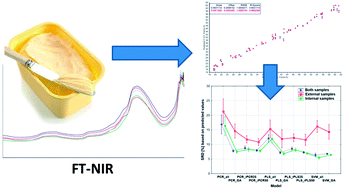当前位置:
X-MOL 学术
›
Anal. Methods
›
论文详情
Our official English website, www.x-mol.net, welcomes your
feedback! (Note: you will need to create a separate account there.)
Development and comparison of regression models for the determination of quality parameters in margarine spread samples using NIR spectroscopy†
Analytical Methods ( IF 2.7 ) Pub Date : 2018-05-24 00:00:00 , DOI: 10.1039/c8ay01055b Anita Rácz 1, 2, 3, 4, 5 , Marietta Fodor 5, 6, 7, 8, 9 , Károly Héberger 1, 2, 3, 4, 5
Analytical Methods ( IF 2.7 ) Pub Date : 2018-05-24 00:00:00 , DOI: 10.1039/c8ay01055b Anita Rácz 1, 2, 3, 4, 5 , Marietta Fodor 5, 6, 7, 8, 9 , Károly Héberger 1, 2, 3, 4, 5
Affiliation

|
Fat and dry material contents (connected to moisture) are one of the most important parameters in the quality control of butter, margarine and margarine spreads (dairy spreads). More than a hundred margarine samples were used to model their fat and dry material content based on Fourier transform-near infrared (FT-NIR) spectroscopy in transmission and reflectance modes for the quality control of margarine. We also carried out a systematic comparison of various modeling techniques such as PLS regression, principal component regression (PCR) and support vector machines (SVM). Moreover, three types of cross-validation, three types of variable selection and the effect of different spectral types (transmission and reflectance) were also compared with factorial ANOVA tests. We examined the effect of the applied datasets (calibration, test samples, and both sets) based on the original predicted values. Sum of ranking differences (SRD), a novel comparison tool, was applied for the task. We showed that the SRD values can be used as a promising and useful performance parameter for the ranking and evaluation of numerous regression models. Four datasets with 42–42 transmission and 34–34 reflectance models were used for the evaluations. Finally, we have found the best models in each case based on their SRD values. The properly validated SVM models proved to be the best for all of the four used datasets. Although the method comparison is data set dependent, the suggested methodology is applicable generally and unambiguously. These final models can be used for fast and easy quality control of margarine samples instead of the time-consuming original analytical techniques.
中文翻译:

使用NIR光谱法开发并比较用于确定人造黄油涂抹样品中质量参数的回归模型†
脂肪和干物质含量(与水分有关)是黄油,人造黄油和人造黄油涂抹酱(乳制品涂抹酱)质量控制中最重要的参数之一。基于透射和反射模式的傅立叶变换近红外(FT-NIR)光谱,对一百多个人造黄油样品进行了脂肪和干物质含量建模,以控制人造黄油的质量。我们还对各种建模技术(例如PLS回归,主成分回归(PCR)和支持向量机(SVM))进行了系统比较。此外,还与阶乘方差分析比较了三种类型的交叉验证,三种类型的变量选择以及不同光谱类型(透射率和反射率)的影响。我们检查了应用的数据集(校准,测试样本,和两组)都基于原始预测值。排名差异总和(SRD)是一种新颖的比较工具,已用于该任务。我们表明,SRD值可用作众多回归模型的排名和评估的有前途和有用的性能参数。评估使用了具有42–42透射率和34–34反射率模型的四个数据集。最后,我们根据其SRD值找到了每种情况下的最佳模型。事实证明,经过正确验证的SVM模型对于所有四个使用的数据集都是最佳的。尽管方法比较取决于数据集,但建议的方法通常适用且明确。这些最终模型可用于人造黄油样品的快速简便的质量控制,而不是耗时的原始分析技术。
更新日期:2018-05-24
中文翻译:

使用NIR光谱法开发并比较用于确定人造黄油涂抹样品中质量参数的回归模型†
脂肪和干物质含量(与水分有关)是黄油,人造黄油和人造黄油涂抹酱(乳制品涂抹酱)质量控制中最重要的参数之一。基于透射和反射模式的傅立叶变换近红外(FT-NIR)光谱,对一百多个人造黄油样品进行了脂肪和干物质含量建模,以控制人造黄油的质量。我们还对各种建模技术(例如PLS回归,主成分回归(PCR)和支持向量机(SVM))进行了系统比较。此外,还与阶乘方差分析比较了三种类型的交叉验证,三种类型的变量选择以及不同光谱类型(透射率和反射率)的影响。我们检查了应用的数据集(校准,测试样本,和两组)都基于原始预测值。排名差异总和(SRD)是一种新颖的比较工具,已用于该任务。我们表明,SRD值可用作众多回归模型的排名和评估的有前途和有用的性能参数。评估使用了具有42–42透射率和34–34反射率模型的四个数据集。最后,我们根据其SRD值找到了每种情况下的最佳模型。事实证明,经过正确验证的SVM模型对于所有四个使用的数据集都是最佳的。尽管方法比较取决于数据集,但建议的方法通常适用且明确。这些最终模型可用于人造黄油样品的快速简便的质量控制,而不是耗时的原始分析技术。











































 京公网安备 11010802027423号
京公网安备 11010802027423号